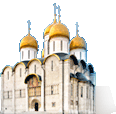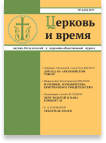
The churches of the Patriarchal Metochion in Chernigovsky Pereulok represent architectural monuments of the 16th-18th centuries registered as part of Moscow’s historical heritage. There is surviving information that in the 14th century this place was occupied by the Monastery of St. John the Baptist-Near-the-Pinewood. Its very name suggests that at the time when the monastery was founded in what is now downtown Moscow, its territory was surrounded by a thick forest. Although the monastery was in the country, it occupied a strategically important place at a crossing of roads leading to the city.
The monastery was first mentioned in the chronicles in 1415 in a story about the birth of Grand Prince Vasily II the Blind.
In the early 17th century, Zarechie (the part of the city on the other side of the river), began to be populated by tradespeople and craftsmen. During the Time of Trouble, the area was repeatedly devastated by invaders only to be soon restored.
In 1514, by the will of Grand Prince Vasily III, the Italian architect Alevis Fryazin (the New), who designed Archangel Michael’s Cathedral in the Moscow Kremlin, replaced the dilapidated wooden monastery church with a stone church dedicated to the Beheading of St. John the Baptist. The church was consecrated on August 29, 1515. And St. John’s Monastery-Near-the-Pinewood itself was abolished and its churches in Chernigovsky Pereulok became parish churches. No precise information about the reasons for abolishing or moving the monastery has been found as yet.
In 1578, it was at the walls of the church of St. John the Baptist that the people, the tsar and the metropolitan met in a solemn ceremony the holy relics of Prince Michael of Chernigov and his faithful Boyar Theodore. To commemorate that meeting, a wooden church dedicated to the Martyrs of Chernigov was built; it was first mentioned in chronicles in 1625. The new church was attached to the church of St. John the Baptist-Near-the-Pinewood. In 1675, the merchant woman by name of Juliana Malyutina donated money to replace it with a stone five-cupola one-sanctuary church, which has survived to this day.
During the 1612 Time of Trouble, the church of St. John the Baptist was destroyed but in 1658 it was rebuilt in stone, with only white-stone fragments of Aleviz’s building surviving in the foundations and the ground floor.
In 1757, a refectory church began to be built to accommodate a new side altar dedicated to the Holy Wonder-workers and Unmercenary Physicians Cosmas and Damian of Asia. It was consecrated in August 17, 1759. In 1772, the cupola of the main church took its final form. Concurrently with the construction of the refectory church, a new detached bell tower began to be built at the corner of Chernigovsky Pereulok and Pyatnitskaya Street. It was completed in 1781.
In the period from 1896-1904, with the help of the architect Fyodor Schechtel, the church, particularly its frescoes and the iconostasis, were renovated.
The churches in Chernigovsky Pereulok did not escape the sad fate of many churches and monasteries after the 1917 Revolution. The church of the Beheading of St. John the Baptist was closed in 1917; the church of the Martyrs of Chernogov soon after it. From 1924, the building of the latter came to accommodate a Baptist prayer house and in the period from 1934-1977, a warehouse. By God’s mercy, the churches escaped full liquidation.
In 1969, M. Bogoyavlensky, one of the leading specialists in the history of Moscow churches, made this description of the state of the church of Ss Michael and Theodore of Chernigov: “The church is beheaded now; the stucco peeled off here and there; the bell tower is painted, there is no gilding; Inside there is a ‘Directorate of Provision of the Trade Department of the Sovetsky District”.
In the second part of the 1970s when the capital of the USSR was preparing to welcome foreign visitors to the 1980 Olympic Games, large-scale restoration work was carried out in it. The Metochion’s churches were restored as well, together with the detached bell tower in Chernigovsky Pereulok. The church of St. John the Baptist acquired a cupola and a cross while inside it some fragments of the 17th and 19th centuries frescoes were discovered. The grating fence was restored. The cupolas of the church of the Martyrs of Chernogov were covered with emerald green tiles and the corbel arches were exposed. The walls of the both churches were plastered and whitewashed; those of the refectory church and the bell tower were painted. The restoration work lasted up to 1984.
The last owner of the churches was the USSR Ministry of Construction Materials Production. In the 20th century 80s, the church of St. John the Baptist housed an exhibition hall ‘Artistic Glass’ which belonged to the ministry.
In 1991, the church of the Martyrs of Chernigov was returned to the Russian Orthodox Church. On October 3, 1993, it was consecrated. In 1997, divine services were also resumed in the church of the Beheading of S. John the Baptist-Near-the-Pinewood.
Today the churches of Chernigovsky Pereulok constitute a Patriarchal Metochion. The restoration work is continued in them.
In June 2010, His Holiness Patriarch Kirill of Moscow and All Russia transferred the Metochion compound to the Ss Cyril and Methodius Institute of Post-Graduate Studies (CMI) and appointed Metropolitan Hilarion of Volokolamsk, CMI rector, as its dean.






